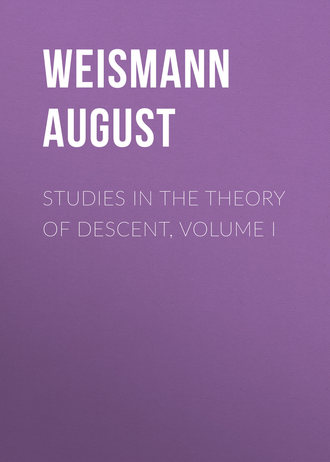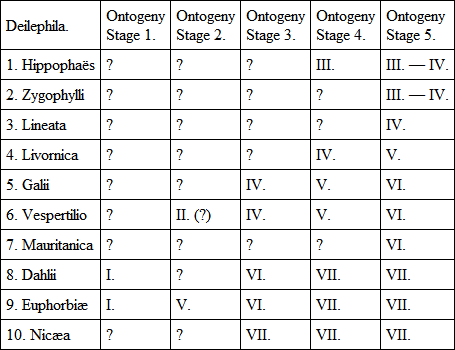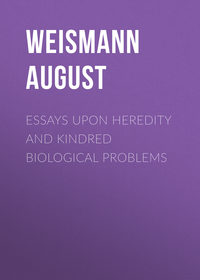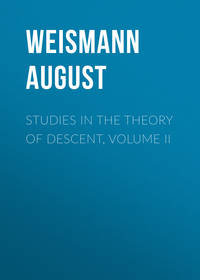 полная версия
полная версияStudies in the Theory of Descent, Volume I
Thus, Nicæa and Euphorbiæ have advanced to the seventh phyletic stage, Zygophylli and Hippophaës only to the third, and some specimens of Zygophylli to the fourth. But at whatever phyletic stage the ontogeny of a species may terminate, the young larval stages always display the older phyletic stages. Thus, Galii in its last ontogenetic stage reaches the sixth phyletic stage; in its penultimate stage it reaches the fifth phyletic stage; and in its third stage; the fourth phyletic stage is represented, so that little imagination is required to anticipate that in the second stage the third or second phyletic stage would be pictured.
If we tabulate the development of the various species, indicating the ontogenetic stages by Arabic numerals, and the stages of the phylogeny which are reached in each stage of the ontogeny by Roman numerals, we obtain a useful synopsis of the series of developments, and, at the same time, it shows how many gaps still remain to be filled up in order to complete our knowledge even of this small group of species.
Table of Development of the Species of Deilephila
From this very incomplete table we perceive that, in certain instances, the stages can be represented as a continuous series of phyletic steps, as in the case of D. Galii; that in others certain steps may be omitted, as with D. Euphorbiæ, in which grade I. of stage 1 is immediately followed by grade V. in stage 2. In reality the gap caused by this omission is still greater than would appear, as grade V. is only indicated, and not actually reached, the subdorsal not being present as a sharply-defined line, but only as a faint stripe. The suppression of phyletic steps increases with the advancement in phyletic development. The higher the step to which a species finally attains, the greater is the tendency of the initial stages to be compressed, or omitted altogether.
From what has thus far been seen with respect to the development of D. Hippophaës, there may be drawn what to me appears to be a very important conclusion, viz. that the ring-spots of Deilephila first originated on the segment bearing the caudal horn, and were then gradually transferred as secondary spots to the preceding segments. Complete certainty would be given to this conclusion by a knowledge of the young forms of other phyletically retarded species, especially those of the American D. Lineata, and perhaps also those of Zygophylli and Livornica. The few observations on the development of D. Galii already recorded give support to this view, since the absence of ring-spots on the three front segments in the young caterpillar (one instance), or their less perfect formation on these segments (second instance), indicates a forward transference of the spots.
If the foregoing view be accepted, there follows from it a fundamental difference between the development of the genera Chærocampa and Deilephila. In the former the formation of the eye-spots proceeds from a subdorsal line, but they first appear on two of the front segments, and are then transferred to the posterior segments. In Deilephila, on the other hand, a single ring-spot is formed on the penultimate segment bearing the caudal horn, and this is repeated on the anterior segments by secondary transference. With respect to the origination of the ring-spot also, there is a distinction between this genus and Chærocampa, inasmuch as the first step towards the eye-formation in the latter consists in the separation of a curved portion of the subdorsal line, whilst in Deilephila the nuclear spot first seems to originate and the separation of the mirror-spot from the subdorsal line appears to occur secondarily. It is difficult here to draw further conclusions, since the first appearance of the primary ring-spot has not yet been observed, and no more certain inference respecting the history of the formation of the primary ring-spots can be drawn from the manner in which the secondary ring-spots are formed. Because in Hippophaës the formation of the secondary ring-spots begins with the red coloration of one or two shagreen-dots, it does not follow that the primary spot on the eleventh segment also originated in this manner; and this is not without importance when we are concerned with the causes which underlie the formation of ring-spots. In Chærocampa also, the formation of the primary eye-spots appears to differ from that of the secondary – in the latter the black “ground-area” first appearing, and in the former the “mirror-spot.” The secondary eye-spots certainly remain rudimentary in this last genus, so that the evidence in support of this conclusion is thus much weakened; but it must be admitted that we are here on ground still too uncertain to admit of wider conclusions being based thereon.
As a final result of the investigation, we may advance the opinion that the existing species of the genus Deilephila have reached five different phyletic stages, and that their very different external appearance is explained by their different phyletic ages; the appearance from these caterpillars of moths so extremely similar, can otherwise be scarcely understood.
It may appear almost unnecessary to bring forward additional proofs in support of this interpretation of the facts, but in a field where the data are so scanty, no argument which can be drawn from them should be considered as superfluous. The variations which occasionally occur in the larvæ, however, to a certain extent furnish a proof of the correctness of the theoretical interpretation offered.
When, in the ontogeny of these species, we actually see before us a series of stages of phyletic development, we must admit that ordinary reversion may occur, causing an adult caterpillar to show the characters of the young. Forms reverting to an earlier phyletic stage must, on the whole, occur but seldom, as this stage is removed further back in the ontogeny. Thus, indications of the subdorsal line must occur but rarely in the adult larvæ of Euphorbiæ, and still less frequently in Nicæa, whilst they must be expected to be of more common occurrence in Vespertilio, and also, as has already been seen, in Dahlii. In this last species, as also in Vespertilio, the completely-developed subdorsal line is still present in the third stage, whilst it is possessed by Euphorbiæ only in the second stage, and then in a rudimentary condition.
The state of affairs may in fact be thus described: Among several hundred adult larvæ of Dahlii found in Sardinia by Dr. Staudinger, there were some which did not actually possess a distinct subdorsal line, but in place thereof, and as its last indication, a feeble light stripe. One of Dr. Staudinger’s caterpillars showed also a distinct line between the closed eye-spots. In the last stage of Vespertilio this line appears still more frequently, whilst in Euphorbiæ it is extremely rare, and when present it only appears as a faint indication. This is the case with one of the specimens figured in Hübner’s work as an “aberration,” and also with one in Dr. Staudinger’s collection. Of Nicæa I have at most seen only eight specimens, none of which showed any trace of the long-vanished subdorsal line.
It must be expected that any ontogenetic stage would most readily revert to the preceding phyletic stage, so that characters present in the preceding stage are consequently those which would most commonly arise by reversion. This postulate of the theory also finds confirmation in the facts. Caterpillars which, when full grown, belong to the seventh phyletic stage, e. g. D. Euphorbiæ, not unfrequently show variations corresponding to the sixth stage, i. e. only one instead of two rows of ring-spots – the upper and first-appearing series. On the other hand, forms reverting to the fifth phyletic stage (ring-spots with connecting subdorsal line) occur but very rarely. I have never met with such cases in adult living caterpillars of D. Euphorbiæ, although in one instance such a larva was found in the fourth ontogenetic stage; but the strikingly dark, brownish subdorsal line which connected the otherwise perfectly developed ring-spots, completely disappeared in the fifth stage of the ontogeny. Those larvæ which, in the adult state, belong to the sixth phyletic stage, not unfrequently show the characters of the fifth stage more or less developed, as, for example, D. Vespertilio.96
THE GENUS SMERINTHUS, LATREILLEThe caterpillars of this genus are very similar in appearance, and all possess extremely simple markings. The occurrence of numerous stages of development of these markings is thus excluded, and the study of the ontogeny therefore promised to furnish less information concerning the phyletic development of the genus than in the case of the preceding genera. This investigation has nevertheless also yielded interesting results, and the facts here recorded will be found of value in likewise throwing light on the causes which have produced the markings of caterpillars.
I shall commence, as in former cases, with the developmental history. I have easily been able to obtain fertile eggs of all the species of Smerinthus known to me. Impregnated females laid large numbers of eggs in confinement, and also bred females of the commoner species can readily be made to copulate, when pinned, and exposed in a suitable place in the open air. A male soon appears under these circumstances, and copulation is effected as readily as though the insect were not fastened in the way indicated.
Smerinthus Tiliæ, Linn. 97The light green eggs are nearly spherical, and after fourteen days (beginning of July) the young larvæ emerge. These are also of a light green colour, and are conspicuous for the great length of the caudal horn, which is nearly half as long as the body. This horn is likewise of a light green at first, but becomes dark violet in the course of an hour. No trace of any markings can be detected at this stage.
As soon as the caterpillars are hatched they commence to nibble the empty egg shells; then they run about with great activity, and after several hours take up their position on the largest vein on the under side of the lime leaves, where they remain for a long period. In this situation they have the same form and colour as the leaf-vein, and are very difficult to discover, which would not be the case if they reposed obliquely or transversely to the vein. In about 4–5 days the caterpillars undergo their first moult, and enter upon the second stage. On each side of the segments 11–4, there now appear seven oblique whitish stripes on a somewhat darker green ground; these slope in the direction of the caudal horn. Owing to the transparency of the skin, a dark green dorsal line appears in the position of the underlying dorsal vessel, the green contents of the alimentary canal being distinctly visible through the absence of adipose matter in the tissues. The larvæ possess also a fine whitish subdorsal line, which extends from the horn to the head. The horn at this stage becomes black with a yellowish red base.
In the third stage, which occurs after six or seven days, the oblique stripes appear darker, and the subdorsal line disappears.
Fourth StageAfter another period of 4–5 days the third moult takes place, and there now commences a dimorphism which will perhaps be better designated as variability, since the two extremes are connected by transitional forms. The majority of the larvæ have, as in the preceding stage, pure white oblique stripes, but many of them possess a blood-red spot on the anterior side of the stripes, this spot showing all gradations in size and depth of colour between maximum development and a mere trace. Special interest attaches to these spots, as they are the first rudiments of the coloured border of the oblique stripes which occurs in so many Sphinx caterpillars.
In the fifth stage – the last of the larval development – the red spots become more strongly pronounced. Among eighty caterpillars from one brood there were about twenty without any red whilst the remainder were ornamented with more or less vivid blood-red spots, often large and irregular in form. In some specimens the spots had become drawn out into lines,98 forming a coloured edge to the oblique white stripes, similar to that possessed by the larva of Sphinx Ligustri. The caterpillar is thus represented in many figures, but generally the coloured stripe is made too regular, as in reality it is always irregularly defined above, and never so sharp and even as in Sphinx Ligustri. The character is here obviously not yet perfected, but is still in a state of development.
Smerinthus Populi, LinnFrom green spherical eggs there emerged larvæ 6.5 millimeters in length without any markings. They were of a light greenish-white, the large head and long caudal horn being of the same colour. The posterior boundary of the segments appears as a light shining ring (Pl. VI. Fig. 55).
The characteristic markings of the genus appear on the following day without the occurrence of any moult: seven oblique white stripes arise from near the dorsal line, and extend along the sides in a direction parallel to that of the horn. On the three front segments they are represented only by three small white spots (Fig. 56). The caterpillar likewise possesses a marking of which the adult species of the genus retain only a trace, viz., a well-developed, pure white subdorsal line, which is crossed by the six anterior oblique stripes, and uniting with the upper part of the seventh extends to the caudal horn.
I long believed that the markings described were first acquired in the second stage, as I was possessed with the generally accepted idea that the changes of form and colour in insects could only occur at the period of ecdysis. I at first thought that the moult had escaped my notice, and I was only undeceived by close observation of individual specimens.
Second StageThe first moult took place after five days, the larvæ being 1.4 centimeters in length. Only unimportant changes of marking are connected therewith. The subdorsal line loses much in thickness and definition, and the first and last of the oblique stripes become considerably broader than the intermediate ones (Fig. 57). The green ground colour and also the stripes acquire a yellowish hue.
On the other hand, there occur changes in form. The head, which was at first rounded, becomes of the characteristic triangular shape, with the apex upwards, common to all the species of the genus, and at the same time acquires two white lines, which unite above at the apex of the angle. The shagreening of the skin now also takes place, and the red spot at the base of the horn is formed.
There appears to be at this stage a general tendency for the suffusion of red, the thoracic legs also becoming of this colour.
Third StageThe second moult occurs after six or eight days, the marking only changing to the extent of the subdorsal line becoming still more indistinct. This line can now only be distinctly recognized on the three front segments in a few individuals, whilst in the majority it is completely absent. Sometimes the ferruginous red spots on the oblique stripes now appear, but this character is not completely developed till the fifth stage. Out of about ninety bred specimens in which I followed the entire development, only one possessed such spots, and these were situated on both sides of the sixth segment.
Fourth StageThe third moult, which takes place after another period of six days, is not associated with any change of marking.
In this stage also I observed in one specimen (not the one just mentioned) the ferruginous spots, and again only on the sixth segment. On account of the theoretical conclusions which may be drawn from this localization of the spots – supposing it to be of general occurrence – it becomes of importance to institute observations with different broods, so as to investigate their first appearance, frequency, and local limitation. It appears to me very probable that, with respect to frequency and time of appearance, there would be great differences, since, in the last stage, it is just this character which shows a great variability. It would be more remarkable if it should be established that the first appearance of the spots was always limited to a certain segment; and there would then be a great analogy with the first appearance of the eye-spots in Chærocampa and the ring-spots in Deilephila.
Fifth StageThe adult caterpillar does not differ in marking to any considerable extent from the preceding stages. The first and last stripes do not appear larger than the intermediate ones, as the latter now increase in size. Many specimens were entirely without red spots; in others they were present, but were small and inconspicuous, whilst in others again there were two spots, one above the other, of a vivid ferruginous red, these coalescing in some cases, and thus forming one spot of a considerable size. I have never seen these spots formed into a regular, linear, coloured border to the white oblique stripes – as occasionally happens in Tiliæ– either in living specimens, blown larvæ, or in figures.
Smerinthus Ocellatus, LinnThe green eggs much resemble those of Populi, as also do the newly hatched caterpillars, which, as in the case of this last species, are entirely without markings. As with Populi, the markings are formed in the course of the first stage, and are distinctly visible before the first moult. The long caudal horn is of a red colour.
After two to three days the caterpillars moult, their length then being one centimeter; the seven beautiful oblique white stripes, and the fine white subdorsal line, are more strongly pronounced, the latter becoming broader in front. They differ from Populi in having the oblique stripes united in the dorsal line.
The second moult occurs after another three days, and brings no important change; only the fine subdorsal line becoming somewhat fainter. Neither is the third moult, which takes place four days later, associated with the appearance of any essentially new character. The oblique stripes remain as before, but their upper portions now stand on a somewhat darker green ground-colour, whilst the subdorsal line vanishes, leaving distinct traces only on the three or four front segments.
The fourth moult follows after a period of seven days, and my bred larvæ underwent scarcely any alteration in marking. Only small differences in coloration became perceptible in the head and horn, these changing to bluish. Specimens occur, although but rarely, which show in this last stage red spots in the vicinity of the oblique stripes, just in the same manner as with Populi, in which species, however, they occur more commonly. I only once found an adult larva of Ocellatus possessing reddish-brown spots above and below the oblique stripes,99 exactly as in one of the specimens figured by Rösel.100
In this stage also there remains almost always on the three to six front segments, a more or less distinct residue of the subdorsal, which extends backwards from the head as a whitish line intersecting the foremost oblique stripes. (Fig. 70, Pl. VII.)
Results of the Developmental History of Smerinthus Tiliæ, Populi and OcellatusFrom the meagre materials furnished by these three obviously nearly related species, we may at least conclude that, with respect to marking, three stages of development can be distinguished: – (1) Simple (green) coloration without marking; (2) subdorsal lines crossed by seven pairs of oblique stripes; (3) more or less complete absence of the subdorsal lines, the oblique stripes remaining, and showing a tendency to become edged with a red border.
Which of the three species is the oldest I will not attempt to decide. If we might venture to form any conclusion from the frequency of the red spots, Tiliæ would be the youngest, i. e., the species which has made the farthest advance. But this does not agree with the fact that the oblique stripes appear somewhat later in this species. Both these distinctions are, however, too unimportant to enable us to build certain conclusions on them. Neither does a comparison of the adult larvæ with other species of Smerinthus furnish any further information of importance.
Of the genus Smerinthus, Latr., thirty species were catalogued by Gray,101 of which I am only acquainted with the larvæ of eight (five European, and three North American). None of these in the last stage possess a complete subdorsal line together with oblique stripes. Neither, on the other hand, do any of them show a more advanced stage of development in having the red spots constantly formed into coloured border-stripes. We must therefore admit that they have all reached nearly the same stage of phyletic development. On turning to the doubtfully placed genus Calymnia, Boisduval, which is represented in Gray by only one species, figured by Westwood102 as a Smerinthus, we first meet with an older stage of development of the genus.
The adult caterpillar of C. Panopus, from the East Indies, possesses, in addition to the oblique stripes, a completely developed subdorsal line,103 and thus corresponds to the first stage of S. Populi. This species may possibly retain in its ontogeny a stage in which the oblique stripes are also absent, whilst the subdorsal line is present. From the early disappearance of the subdorsal line in the species of Smerinthus, we may venture to conclude that this character appeared at an early stage of the phylogeny, whilst the oblique stripes represent a secondary form of marking, as shall be further established subsequently.104
THE GENUS MACROGLOSSA, OCHSENHEIMERThe adult larvæ of five species are known, and to these I can now add a sixth. In Gray the genus contains twenty-six species.105 I cannot find any figures or descriptions of the young stages of these caterpillars, and I have myself only observed the complete ontogeny of one species.
By placing a captured female M. Stellatarum in a capacious breeding-cage, in the open air, I was enabled to procure eggs. The moth hovered about over the flowers, and laid its small, grass-green, spherical eggs (partly when on the wing), singly, on the leaves, buds, and stalks of Galium Mollugo. Altogether 130 were obtained in three days.106
First StageAfter about eight days the caterpillars emerge. They are only two millimeters in length, and are at first yellowish, but soon become green, set with small single bristles, and they possess a short greenish caudal horn, which afterwards becomes black. The head is greenish-yellow. The young larvæ are entirely destitute of marking. (Pl. III., Fig. 1).
Second StageThe first moult takes place after four days, the caterpillar now acquiring the marking which it essentially retains to pupation.
Fine white subdorsal and spiracular lines appear, and at the same time a dark green dorsal line, which, however, does not arise from the deposition of pigment, as is generally the case, but from a division in the folds of the fatty tissue along this position. (Fig. 2, Pl. III.)
The colour is now dirty green in all specimens, the skin being finely shagreened.
Third StageThe second moult, occurring after another period of four days, does not bring any change of marking, the colour only becoming somewhat darker. Length, twelve millimeters.
Fourth StageThe third moult (after another four days) likewise brings only a change of colouring, which is of such a nature that the caterpillar becomes dimorphic. At the same time that peculiar roughening of the skin takes place which, in the case of Chærocampa, was designated as “shagreening.” The colour is now light grass-green in some specimens, and dark green in others; in these last the subdorsal line is edged above with dark brown, and the spiracles are also of this colour. Length, seventeen millimeters.
Fifth StageFour days later, after the fourth ecdysis, the dimorphism becomes a polymorphism. Five chief types can be distinguished: —






